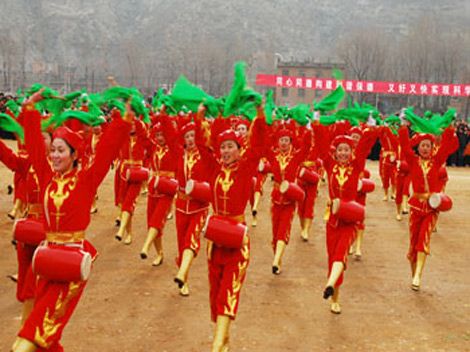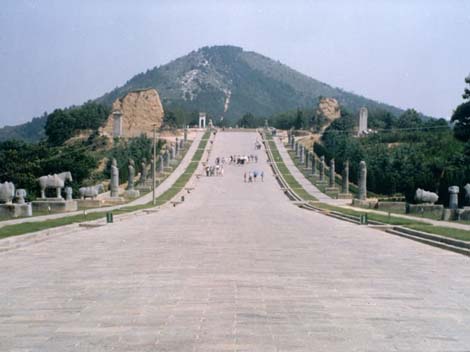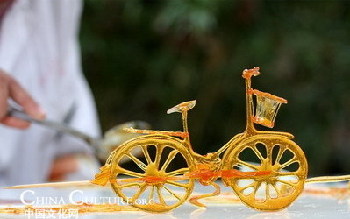From the introductory section written by Sidney Shapiro
The Underground Terracotta Army of Emperor
Qin Shi Huang, edited by Fu Tianchou
New World Press, Beijing
The imperial tomb of Qin Shi Huang (259-210B.C), the first emperor of China and founder of the short-lived Qin Dynasty (211-206 B.C.), lies 35 kilometers east of the city of Xi;’an, in Lintong County, Shaanxi Province.
The tomb was 36 years in the building, having been commenced one year after Ying Zheng, the future first emperor, became head of the state of Qing in 246 B.C. The mausoleum was part of the lavish construction program, which characterized his reign.
Achievements of Emperor Qin Shi Huang
By 221 B.C., King Zheng annexed the six other independent kingdoms of the warring States Period (403-221 B.C.) and founded the first unified feudal empire in Chinese history, proclaiming himself Shi Huang Di, or the first emperor of the Qin Dynasty.
Emperor Qin Shi Huang was a man of remarkable talents and achievements. His military conquests were in part the result of a superb mastery of the newest arts of war. He abolished the system of feudal enfoeffment and created a form of centralized, autocratic government, which was maintained in essence to the fall of the last (Qing) Dynasty in the early 20th century. He promulgated a uniform code of law and standardized currency, weights and measures, the written language and the axle length of wagons and chariots. He built a vast network of tree-lined roads so paces wide, radiating from the Qin capital, Xianyang, 20 kilometers northwest of Xi’an. He joined into a single 3,000 kilometer “Great Wall” (extended to 6,000 kilometers during later dynasties) the separate walls erected by the earlier northern states to deter the raiding nomadic tribes.
Palaces for the Living and the Dead
For his personal Glorification, Emperor Qin Shi Huang built a number of elaborate palaces, the largest of which was the E Pang Palace situated in the southwest of present-day Xi’an. The reception hall of this legendary palace was some 1,000 meters long and over 150 meters wide, and could hold 10,000 people. Several hundred thousand laborers were conscripted for the construction of the palace. The only other colossal undertaking that matches this magnificent palace was the first Emperor’s mausoleum.
On the slopes of Li Mountain and to the south of the Wei River, the tomb mound, now 76 meters in height and 1250 meters in perimeter, was originally enclosed by rectangular inner and outer walls respectively 4 and 6 kilometers in perimeter.
Although the entire mausoleum remains to be explored and excavated, we know from written records that it was an underground palace complex. According to Sima Qian, who wrote his records of the historian (shiji) some 100 years after the First Emperor’s death, the ceiling of the tomb chamber is a molel of the heavens and its floor map of the empire: jewels and other treasures buried within are guarded by devices triggered to release arrows at any intruder; and the workmen who installed the finishing touches were buried alive to ensure that the secret of the entranceway died with them.
If this is all true, the underground sepulcher is indeed in keeping with the grand style maintained by the First Emperor during is lifetime. Archaeologists have long suspected that there must be more to the imperial interment than what Sima Qian described. In the Zou Dynasty (c. 1066-256 B.C.), members of the aristocracy were buried with retinues of sculptural figures to accompany them on their journeys to the nether world. In earlier dynasties, human beings and animals were ritually sacrificed and entombed together with the deceased. Where was the First Emperor's entourage?
Discovery of Warrior and Horse Figure Pits
After two millennia of silence, the answer was provided by a chance discovery made in March 1974. In the course of digging a well in a field 1.5 kilometers east of the mausoleums, the peasants of the Xiyan Production Team of the Yanzhai Commune unearthed a number of fragments of terracotta warriors and horses which experts identified as dating from the Qin Dynasty. The area now called Pit No. 1 was placed under the protection of the central government’s Bureau of Historical Relics, while the task of excavation was entrusted to Shannxi Provincial Committee for the Protection and Preservation of Historical relics.
Following the discovery of Pit No. 1, Pit No. and No. 3 were found in May and June 1976 respectively. These two pits were also excavated but were refilled with soil later. Excavation shows that all the three Pits of lifesize pottery figures were originally roofed over and lined with a framework of earth and wood which collapsed long ago. The first two pits were damaged in a fire (possibly razed by the rebel forces under Xiang Yu, who is said to have set the palaces and tomb Emperor Qin Shi Huang on fire after defeating the Qin forces), while the third pit caved in by itself. As a result, most of the pottery figures were reduced to fragments.
A still more recent and amazing find at the site of the First Emperor’s mausoleum was a pair of four-horse chariots, each with a charioteer, all cast in bronze. These artifacts were unearthed
 more
more


 more
more




 print
print  email
email  Favorite
Favorite  Transtlate
Transtlate 







